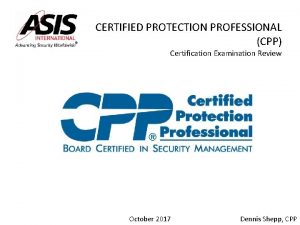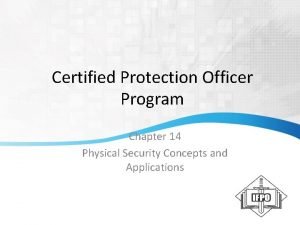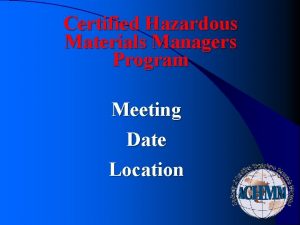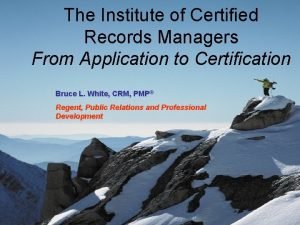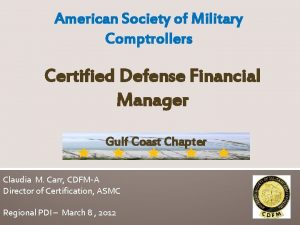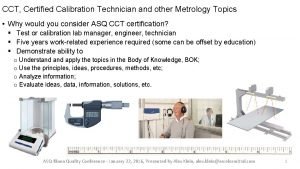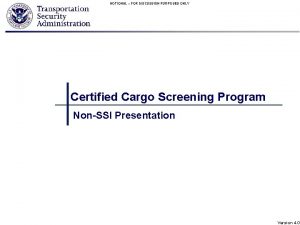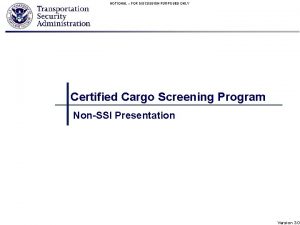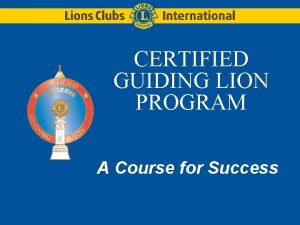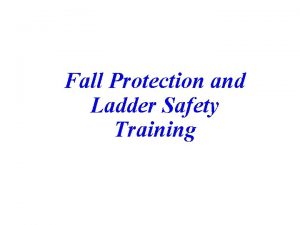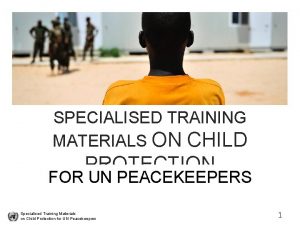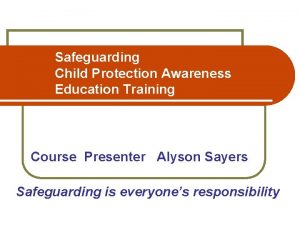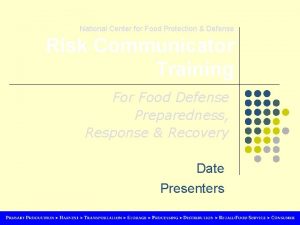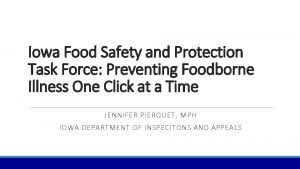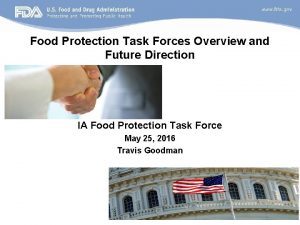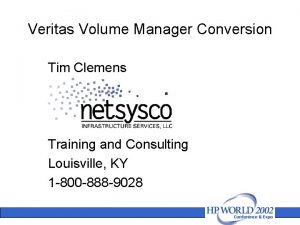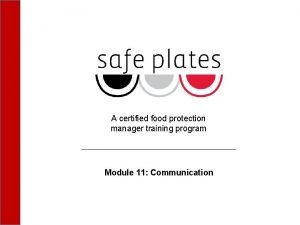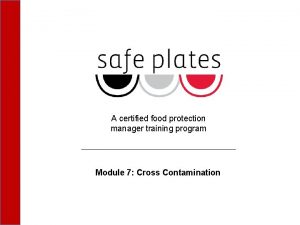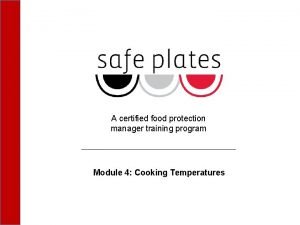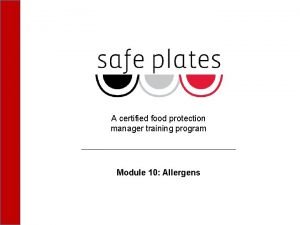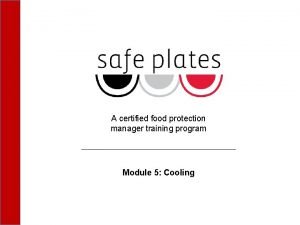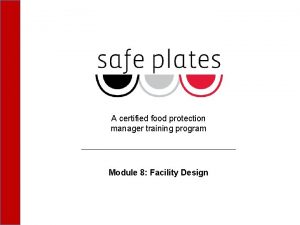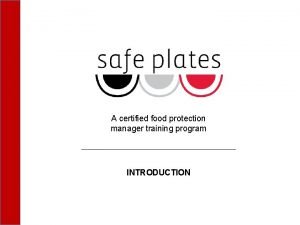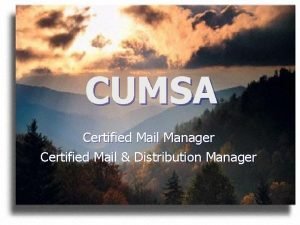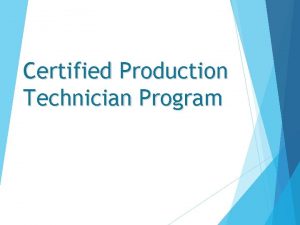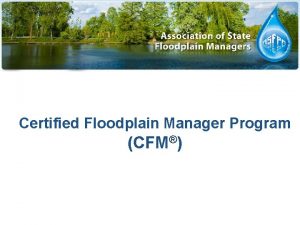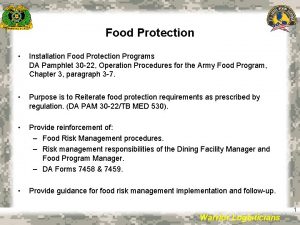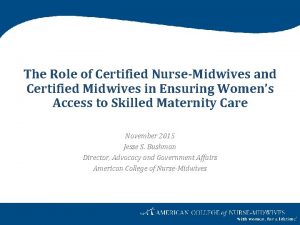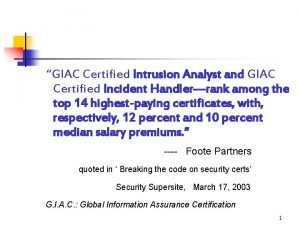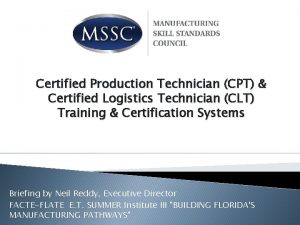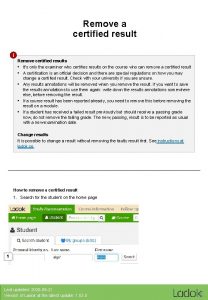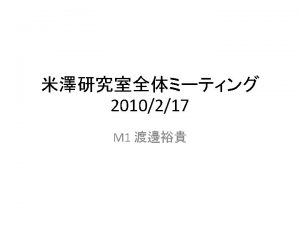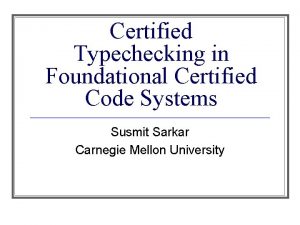A certified food protection manager training program Module


































- Slides: 34

A certified food protection manager training program Module 3: Storage

Food Storage Practices at: Firefly owner John Simmons poses at his restaurant at 3824 Paradise Road in Las Vegas on Monday Nov. 18, 2013. (Bill Hughes/Las Vegas Review-Journal)

Q&A with Firefly Tapas Kitchen & Bar co-owner John Simmons By JENNIFER ROBISON LAS VEGAS BUSINESS PRESS, November 23, 2013 It’s every restaurateur’s worst nightmare. Firefly Tapas Kitchen & Bar had to close its Paradise Road doors in April because of an outbreak of salmonella. The outbreak, which public-health officials traced to contaminated chorizo, sickened nearly 300 people from 27 states and forced changes in how the company ran its kitchen.

What Happened? The Facts: The chorizo came into the restaurant raw and was cooked by Firefly restaurant staff. The outbreak strain of Salmonella was isolated from the cooked chorizo. Health officials say there is only a “Small possibility that raw chorizo was contaminated prior to arriving at Firefly. ”

How could pre-cooked product be contaminated with Salmonella? • While it was happening…

Learning Objectives • Describe symptoms, sources and control of Salmonella • Define and list examples of TCS foods • Explain and list p. H and water activity of TCS foods • Describe the best storage practices for foods to prevent contamination

Key Terms • Time/Temperature Control for Safety - a food that requires strict control of time and temperature to limit pathogenic microorganism growth and/or toxin formation • Ready-to-eat foods – foods that can be consumed without preparation or treatment, such as washing or cooking, immediately before they are eaten.

Examples TCS Foods • Animal products: – Raw meat and poultry – Cooked meat and poultry – Milk and dairy products – Raw shell eggs and uncooked/lightly cooked – Raw or cooked fish and shellfish • Produce and Grains – Cooked beans, pasta, rice and potatoes – Cut, prepared fresh fruits and vegetables – Cut leafy greens – Garlic and oil mixtures • Is there anything missing from this list?

Example: Cantaloupe Whole Cantaloupe IS NOT a TCS food, but cut Cantaloupe IS! Why do you think that is?

TCS Foods are Low Acid Foods Low acid foods have a p. H above 4. 6, meaning not a lot of acid in the product. • p. H scale goes from 0 (acid) to 14 (base)

TCS Foods are High Moisture Foods aw = Water activity aw goes from 0 (no available water) to 1 (pure water) Bacteria need moisture to grow; need foods with high moisture and aw above 0. 85 – This means 85% of the water is free for the bacteria to use

Ready-to-Eat Foods (RTE) RTE foods that can be consumed without preparation or treatment, such as washing or cooking, immediately before they are eaten. • Raw washed fruits and vegetables • Prepared salad vegetables • Deli items – Ex: cheese, cold meats, hot dogs • Cooked foods ready for service – Ex: chorizo from our case study

Salmonella • Characteristics: – Slow to no growth below 41 o. F – Dies with high temperature (over 165 o. F) – Needs moisture to grow – Very tough, can survive for a long time in dry conditions • Commonly associated with chicken and eggs. Also fruits, vegetables, and even dry foods like spices and peanut butter. • Pets like turtles and lizards can carry Salmonella.

Salmonella 1) From Food – Gastrointestinal illness: nausea, vomiting, diarrhea, cramps, and fever lasting for a few days to a week. – Symptoms start 6 -72 hours after exposure. 2) From Food Handler – Typhoid (Typhoid fever): fever, diarrhea, aches, headache, and sluggishness. Rash sometimes occurs. – Symptoms start 1 -3 weeks after exposure, sometimes out to 2 months. Symptoms last 2 -4 weeks. Type of illness depends on the type of Salmonella bacteria.

Remember Our Case Study? How could storage be a factor?

Time • Label foods (both your storage containers and original containers) • Rotate Stock: First in First out (FIFO) – Not FILO, FISH • Schedule to deplete stores on a regular basis • Discard food past the use-by dates

Cross Contamination • Placement in storage – Separate raw and ready-to-eat foods as much as possible – Ready-to-eat foods stored above meats – Store raw meats (based on cooking temp) – Proper containers, lids and covers – Storage in designated areas only – Keep things clean and dry • Clean dollies and carts

Refrigerated Storage RTE Foods (not cooked) Whole meats, Fish (145 o. F) Ground meats (155 o. F) Poultry (165 o. F)

Temperature • Temperature Danger Zone – Hot foods hot, cold food cold • Check temperature – Do you keep a record? • Cooling and overloading – More on this later

Frozen Storage • • Temperature keeps all products frozen Receiving frozen foods Freezing hot foods can raise temperature Proper air circulation Defrosting Labeling (will it stick? ) Remember it is being opened constantly!

Refrigerated Storage • Keep TCS Foods at 41°F or below – Can be 45°F in NC for now, must comply by 2019 • Monitor temperature regularly • Don’t overload if used for cooling • Proper air circulation • Wrap and cover foods properly • Prevent cross contamination

Dry Storage • Cool and dry – 50 -70°F – Relative humidity 5060% • Well ventilated • Keep products away from walls, 6” off floor • Avoid sunlight

Storage Continued Don’t store food: – In bathrooms, locker rooms, mechanical rooms, under sewage lines, or under piping – Near chemicals – With personal items Proper storage of personal items – Away from food storage – Includes: • Personal food and drinks • Medication

What’s Your View? What are different methods to label containers? How would you manage FIFO and timely rotation of stock in a walk-in cooler?


How Could This Have Been Prevented?

How They Responded November 2013 “… and forced changes in how the company ran its kitchen. It hired a dedicated food-safety expert, signed up chefs and managers for foodhandling certification classes and added a program to monitor food safety at potential contamination points. The goal? To become an “industry leader” in food safety, coowner John Simmons said. ”

And on April 15, 2014 …

Discuss How will you verify that best practices for storage are being followed by employees? What will you look for? How will you respond to improper storage?

Quiz Checking the walk-in refrigerator, you see food stored in the following ways. Which one would you correct IMMEDIATELY? a) Raw foods are stored on a shelf above ready-to-eat foods b) Loosely covered foods are cooling on the top shelf c) Ice bath is being used to cool spaghetti sauce in a shallow pan d) Food being stored in plastic containers with tight-fitting lids after cooling

Quiz Checking the walk-in refrigerator, you see food stored in the following ways. Which one would you correct IMMEDIATELY? a) Raw foods are stored on a shelf above ready-to-eat foods b) Loosely covered foods are cooling on the top shelf c) Ice bath is being used to cool spaghetti sauce in a shallow pan d) Food being stored in plastic containers with tight-fitting lids after cooling

Quiz What is the maximum storage temperature for refrigerated storage? a) 55 o. F b) 45 o. F c) 41 o. F d) 35 o. F

Quiz What is the maximum storage temperature for refrigerated storage? a) 55 o. F b) 45 o. F c) 41 o. F d) 35 o. F

Review • TCS foods • Salmonella • Proper food storage – Refrigerated – Dry – Frozen
 Certified protection professional
Certified protection professional International foundation for protection officers
International foundation for protection officers Certified protection officer
Certified protection officer Certified exhibition manager
Certified exhibition manager Certified hazardous materials manager
Certified hazardous materials manager Certified records manager
Certified records manager Certified healthcare facility manager
Certified healthcare facility manager Cdfm certification
Cdfm certification Module sur la protection transversale
Module sur la protection transversale Vrf error code list
Vrf error code list Asq cct
Asq cct Certified training professional
Certified training professional Pella certified contractor
Pella certified contractor Tsa certified cargo screening program
Tsa certified cargo screening program For discussion purposes only disclaimer
For discussion purposes only disclaimer Certified guiding lion
Certified guiding lion Senior manager vs general manager
Senior manager vs general manager Portfolio manager synergy manager parental developer
Portfolio manager synergy manager parental developer Unit 2 food food food
Unit 2 food food food Food chain food chain food chain
Food chain food chain food chain C device module module 1
C device module module 1 Who trains employees that work on scaffolds
Who trains employees that work on scaffolds Fall protection training outline
Fall protection training outline Child protection training materials
Child protection training materials Child protection awareness training
Child protection awareness training National center for food protection and defense
National center for food protection and defense Www.youtube.com
Www.youtube.com Iowa food protection task force
Iowa food protection task force Plpp primerica
Plpp primerica Community air protection program
Community air protection program Witness protection program philippines
Witness protection program philippines Veritas volume manager tutorial
Veritas volume manager tutorial Notam manager training
Notam manager training Ucla fau
Ucla fau Street manager training
Street manager training
